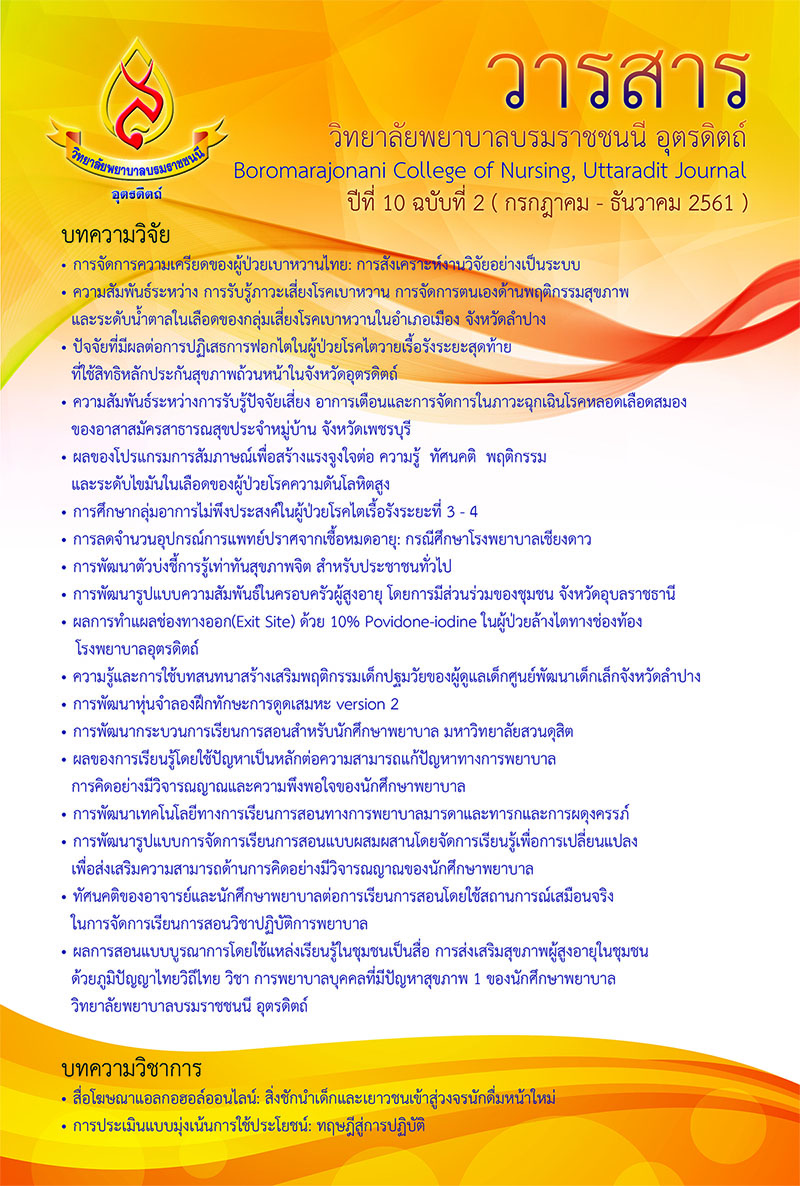ความสัมพันธ์ระหว่างการรับรู้ปัจจัยเสี่ยง อาการเตือนและการจัดการในภาวะฉุกเฉินโรคหลอดเลือดสมองของอาสาสมัครสาธารณสุขประจำหมู่บ้าน จังหวัดเพชรบุรี
Main Article Content
บทคัดย่อ
การวิจัยครั้งนี้เป็นการศึกษาความสัมพันธ์ระหว่างการรับรู้ปัจจัยเสี่ยง อาการเตือนและการจัดการในภาวะฉุกเฉินโรคหลอดเลือดสมองของอาสาสมัครสาธารณสุขประจำหมู่บ้าน จังหวัดเพชรบุรี กลุ่มตัวอย่างเป็นอาสาสมัครสาธารณสุขประจำหมู่บ้านจำนวน 97 คน เครื่องมือที่ใช้ในการเก็บข้อมูลได้แก่ แบบสัมภาษณ์ข้อมูลส่วนบุคคล แบบสอบถามการรับรู้ปัจจัยเสี่ยง แบบสอบถามการรับรู้อาการเตือน แบบสอบถามการจัดการในภาวะฉุกเฉิน และแบบประเมินความหมายของตัวย่อ FAST วิเคราะห์ข้อมูลโดยใช้สถิติเชิงพรรณนา สัมประสิทธิ์สหสัมพันธ์เพียร์สันและไคสแคว์ ผลการศึกษาพบว่า การรับรู้ปัจจัยเสี่ยงโรคหลอดเลือดสมอง เท่ากับ 8.19 จากคะแนนเต็ม 10 อยู่ในระดับดี การรับรู้อาการเตือนโรคหลอดเลือดสมองเท่ากับ 8.29 จากคะแนนเต็ม 12 อยู่ในระดับปานกลาง การจัดการในภาวะฉุกเฉินโรคหลอดเลือดสมอง โดยกลุ่มตัวอย่างร้อยละ 88.70 ตอบว่าโทรไปที่สายด่วนฉุกเฉิน 1669 ส่วนการประเมินสัญลักษณ์/ตัวย่อของอาการโรคหลอดเลือดสมองคือ FAST ค่าคะแนนเฉลี่ยการตอบถูกต้องของแต่ละตัวอักษรเท่ากับ 2.90 จากคะแนนเต็ม 4 การรับรู้ปัจจัยเสี่ยงไม่มีความสัมพันธ์กับการจัดการภาวะฉุกเฉินโรคหลอดเลือดสมอง แต่พบว่าการรับรู้ปัจจัยเสี่ยงมีความสัมพันธ์ทางบวกกับการรับรู้อาการเตือน อย่างมีนัยสำคัญทางสถิติ (r = .005, p < .01) และการรับรู้อาการเตือนมีความสัมพันธ์ทางบวกกับการจัดการในภาวะฉุกเฉินโรคหลอดเลือดสมอง อย่างมีนัยสำคัญทางสถิติ (r = .008, p < .01) จากการศึกษาพบว่า อสม. ที่มีการรับรู้ปัจจัยเสี่ยงจะมีการรับรู้อาการเตือนที่ดีและจะทำให้เกิดการจัดการในภาวะฉุกเฉินโรคหลอดเลือดสมองที่ดีตามไปด้วย
Article Details
บทความหรือข้อคิดเห็นใดใดที่ปรากฏในวารสารวิจัยการพยาบาลและวิทยาศาสตร์สุขภาพ เป็นวรรณกรรมของผู้เขียน ซึ่งบรรณาธิการหรือสมาคมศิษย์เก่า ไม่จำเป็นต้องเห็นด้วย และบทความที่ได้รับการตีพิมพ์เผยแพร่ถือเป็นลิขสิทธิ์ของวารสารวิจัยการพยาบาลและวิทยาศาสตร์สุขภาพ
เอกสารอ้างอิง
2. Bloom, B. (1956). Bloom’s taxonomy of learning domains. Retrived October 2, 2017, from www.nbna.org/files/Blooms%20Taxonomy%20of%20Learning.pdf.
3. Bureau of Non Communicable Diseases, Department of Disease Control, Ministry of Public Health (2017). Pocket book for risk assessment of ischemic heart disease and stroke for village health volunteer (2nd edition), 1-36. Bangkok: WVO office of Printing Mill. (in Thai)
4. Chiangthong, K. (2011). Relationships between the health belief model, warning signs perception and management of stroke behavior in the risk group of stroke, Doi Saket District, Chiang Mai Province. (Master of public health thesis), Chiang Mai University. (in Thai)
5. Jauch, E.C., Saver, J.L. & Adams, H.P., et al. (2013). Guidelines for the early management of patients with acute ischemic stroke: A guideline for healthcare professionals.The American Heart Association. Stroke, 44 (3), 870-947.
6. Kumpangkaew, K., Somboontanont, W. & Leelahakul, V. (2015). Relationships between perceived risk, Perceived warning signs and self-care behavior in older adults at risk of cerebrovascular disease. Nursing Journal of the Ministry of Public Health, 25(2), 40 - 56. (in Thai)
7. Nualnetr, N, et al. (2008). A study of village health volunteers’ knowledge and daily living behavior on the stroke. KKU Research Journal, 13(7), 807-818. (in Thai)
8. Phudhichareonrat, S. (2011). Neuroanatomy and function of intracranial and extracranial vessels. Retrived February 16, 2017, from https:// www.phn.bangkok.go.th/index.php?option=com_docman&task.
9. Primary Health Care Division. (2017). People health information system. Retrived September 21, 2017, From https://www.thaiphc.net/thaiphcweb/index.php?r=site/main. (in Thai)
10. Seesawang, J., & Thongtang, P. (2016). Post-stroke depression among older adult stroke survivors. Boromarajonani College of Nursing, Uttaradit Journal, 8(2), 73-85. (in Thai)
11. Shigehatake, Y., et al., (2014). Stroke education using an animated cartoon and a manga for junior high school students. Journal of Stroke and Cerebrovascular Diseases, 23(6), 1623-1627.
12. Strategy and Planning Division, Ministry of Public Health. (2017). Public health statistics A.D.2017. Nonthaburi, Thailand: Strategy and Planning Division. (in Thai)
13. Thonghong, A., Thepsittha, K. & Chogpiriyaanan, P. (2012). Chronic disease surveillance report, 2012. Retrieved June 21, 2017, from: https://www.boe.moph.go.th/ files/report/20140109_40197220.pdf.
14. Tippayanate, N. & Chanabutr, W. (2016). Knowledge of stroke risk factors and warning signs: a case study of the Stroke education program in Mahasarakham factory. Retrieved June 21, 2017, from: https://www.niems.go.th/th/Upload/File/255911291539072135_dE7hVSOZkKEUPi6z.pdf.
15. World Health Organization. (2017). Stroke, cerebrovascular accident. Retrieved October 13, 2017, from: https://www.who.int/topics/cerebrovascular_accident/en/.


